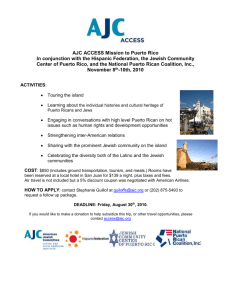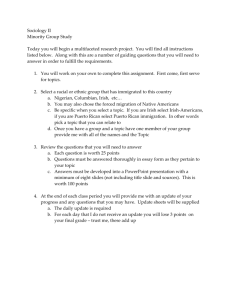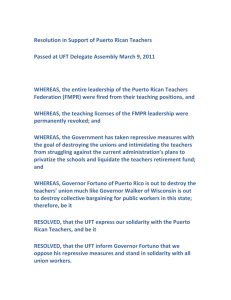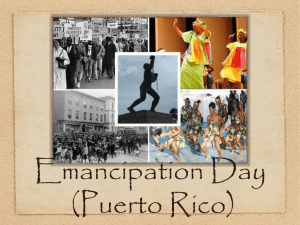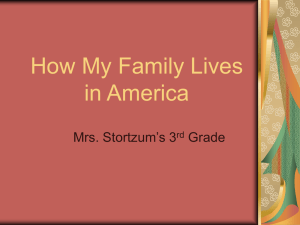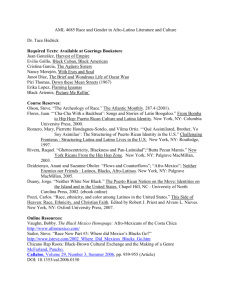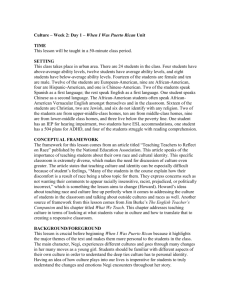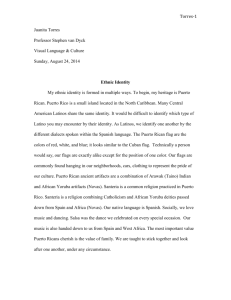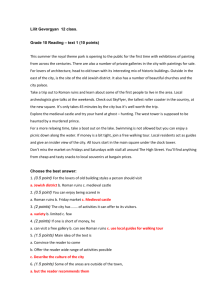7.1 Sample Lesson - Analyzing Puerto Rican Folk Tales
advertisement
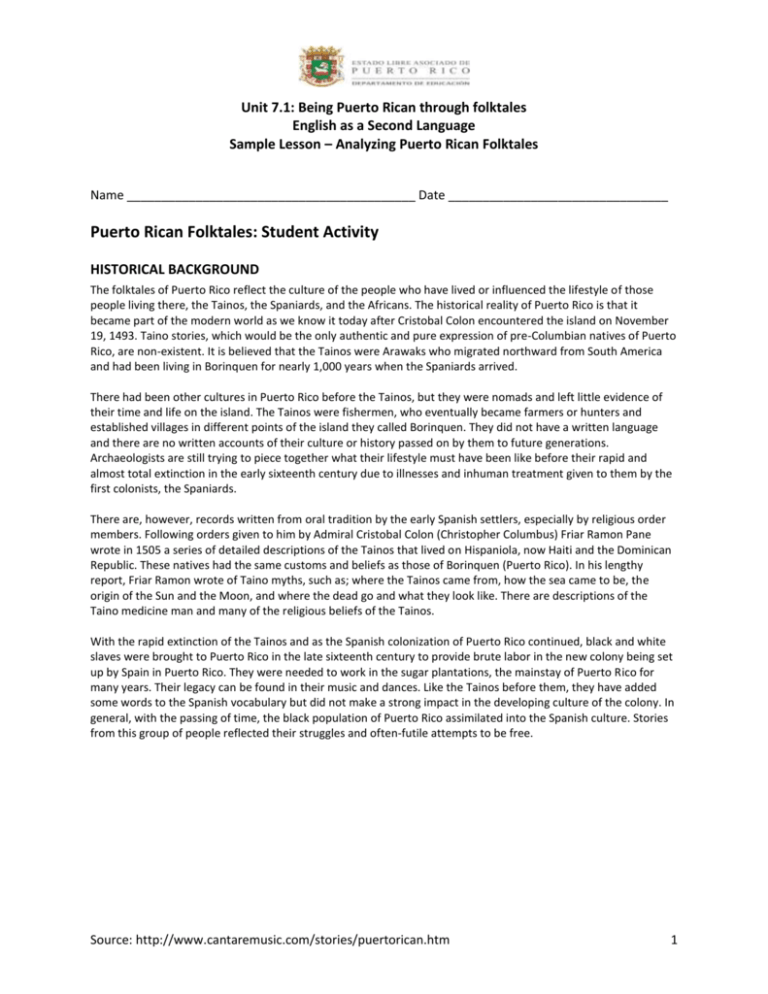
Unit 7.1: Being Puerto Rican through folktales English as a Second Language Sample Lesson – Analyzing Puerto Rican Folktales Name __________________________________________ Date ________________________________ Puerto Rican Folktales: Student Activity HISTORICAL BACKGROUND The folktales of Puerto Rico reflect the culture of the people who have lived or influenced the lifestyle of those people living there, the Tainos, the Spaniards, and the Africans. The historical reality of Puerto Rico is that it became part of the modern world as we know it today after Cristobal Colon encountered the island on November 19, 1493. Taino stories, which would be the only authentic and pure expression of pre-Columbian natives of Puerto Rico, are non-existent. It is believed that the Tainos were Arawaks who migrated northward from South America and had been living in Borinquen for nearly 1,000 years when the Spaniards arrived. There had been other cultures in Puerto Rico before the Tainos, but they were nomads and left little evidence of their time and life on the island. The Tainos were fishermen, who eventually became farmers or hunters and established villages in different points of the island they called Borinquen. They did not have a written language and there are no written accounts of their culture or history passed on by them to future generations. Archaeologists are still trying to piece together what their lifestyle must have been like before their rapid and almost total extinction in the early sixteenth century due to illnesses and inhuman treatment given to them by the first colonists, the Spaniards. There are, however, records written from oral tradition by the early Spanish settlers, especially by religious order members. Following orders given to him by Admiral Cristobal Colon (Christopher Columbus) Friar Ramon Pane wrote in 1505 a series of detailed descriptions of the Tainos that lived on Hispaniola, now Haiti and the Dominican Republic. These natives had the same customs and beliefs as those of Borinquen (Puerto Rico). In his lengthy report, Friar Ramon wrote of Taino myths, such as; where the Tainos came from, how the sea came to be, the origin of the Sun and the Moon, and where the dead go and what they look like. There are descriptions of the Taino medicine man and many of the religious beliefs of the Tainos. With the rapid extinction of the Tainos and as the Spanish colonization of Puerto Rico continued, black and white slaves were brought to Puerto Rico in the late sixteenth century to provide brute labor in the new colony being set up by Spain in Puerto Rico. They were needed to work in the sugar plantations, the mainstay of Puerto Rico for many years. Their legacy can be found in their music and dances. Like the Tainos before them, they have added some words to the Spanish vocabulary but did not make a strong impact in the developing culture of the colony. In general, with the passing of time, the black population of Puerto Rico assimilated into the Spanish culture. Stories from this group of people reflected their struggles and often-futile attempts to be free. Source: http://www.cantaremusic.com/stories/puertorican.htm 1 Unit 7.1: Being Puerto Rican through folktales English as a Second Language Sample Lesson – Analyzing Puerto Rican Folktales The culture of the Puerto Rico of today is predominantly Spanish with traces of Taino Indian and Black influences. According to the American Heritage Dictionary, “culture” is defined as “the arts, beliefs, customs, institutions, and all other products of human work and thought created by a people or group at a particular time.” The Spanish acculturation process of Puerto Rico began almost five hundred years ago; three cultures (possibly multiple cultures) came together in Puerto Rico soon after that fateful day of November 19, 1493. The folk tales that are told in Puerto Rico today reflect basically Spanish themes with island adaptations and very little Taino or African participation. The tales, in general, have undergone changes in numbers, names, or settings, which are more tropical or similar to Puerto Rico. OBJECTIVES This curriculum unit will contain several tales from the oral tradition from Puerto Rico. In each case, a short summary will be given for each tale with a brief historical background and if possible the location of the tale will be included. In order to work with these folk tales, the students will be asked to analyze the story through identification of its characters, the problem or problems in the tale, the setting, sequence of events, and the solution of the problem(s). Other elements that will also have to be identified are: the lesson or moral, magic, evil vs. good, good conquers evil, talking animals, ordinary people, magic numbers, punishment/reward, trickery, greed, exaggeration. Not all the elements will or can be found in a single folk tale, but students need to know which ones are present in the tale that they are reading. Student opinions on the tales are also important; these stories teach a lesson and should be entertaining at the same time. Source: http://www.cantaremusic.com/stories/puertorican.htm 2 Unit 7.1: Being Puerto Rican through folktales English as a Second Language Sample Lesson – Analyzing Puerto Rican Folktales MYTH Taino Origin of the Sea There was a man named Yaya who had a son Yayael, whose name means son of Yaya. Yayael wanted to kill his father. When Yaya found out that his son wanted to kill him, he had him exiled for four months and then killed him himself. Yaya put his son’s bones in a gourd, which he hung from the ceiling of his house, and here it hung for some time. One day, Yaya wanted to see his son and said to his wife,” I want to see our son Yayael.” His wife felt great joy, brought the gourd to her husband, and turned it over to empty out the son’s bones. Large and small fish came out of the gourd, and they realized that their son’s bones had turned into fish and decided to eat them. Later, one day when Yaya was out in his conucos, which means possessions or lands, the four children of a woman named Itiba Tahuvava came to his house. Their mother had died giving birth to the four and the first one to be born was Caracaracol, whose name means scabby or leprous. The others did not have names. Itiba Tahuvava’s four identical sons went together to steal Yayals gourd where the bones of his son Yayael were kept. Of the four brothers only Dimivan Caracaracol dared to bring the gourd down from its place but all four ate the fish they found inside it. While they were eating, they heard Yaya returning from his conucos, and in the confusion that followed, when they tried to put the gourd back in its place, it fell and broke. People say that so much water came out of the gourd that it covered the whole earth and along with the water fish of all sizes came out too. This, according to Taino myth is the origin of the sea. This and other fascinating myths and descriptions are found in the work of Friar Ramon in his report to Admiral Cristobal Colon, which can be read in its totality in Crónicas de Puerto Rico by Eugenio Ferndandez Mendez. Source: http://www.cantaremusic.com/stories/puertorican.htm 3 Unit 7.1: Being Puerto Rican through folktales English as a Second Language Sample Lesson – Analyzing Puerto Rican Folktales LEGEND One of the first legends retold in Puerto Rico is that of Guanina by Dr. Cayetano Coll y Toste. Once the Taino Indians had proven that the Spaniards were not immortal through the death of Diego Salcedo, they rebelled. The legend of Guanina tells of that rebellion. GUANINA Guanina was a Taino Indian princess in love with Don Cristobal de Sotomayor, a Spanish officer who had come to Borinquen to conquer and colonize. Her brother, Guaybana, was the principal chief of the Tainos who hated the Spaniards because of the way they had mistreated and betrayed the Tainos. He swore revenge against the Spaniards. Juan Gonzalez, Sotomayor’s aide, found out about the plan to kill his captain and tried to warn him. Sotomayor would not hear of the planned uprising. He sent for Guaybana and for some of his men to carry his baggage, since he was going to Caparra, the capital. Guanina begged him not to go because she knew that he was going to die and that it would be her own brother who would kill him. Sotomayor did not change his plans, and the next morning set out with Guaybana and his men to the city. On the way, he and five other Spaniards were attacked by the Tainos, and Sotomayor was killed. When Guanina was given the news of her lover’s death, she tried to bring him back to life through her kisses and caresses. The Taino elders considered Guanina a traitor, and decided to offer her as a sacrifice to the gods as a sign of their gratitude in succeeding in their attack. When they went to get Guanina, they found her dead with her head resting on Sotomayor’s bloody chest. The two were buried together near a giant ceiba tree and on their tomb red hibiscus and white lilies appeared as if by magic. These flowers represent the true and passionate love these two souls felt for each other. The legend has it that on occasion, the huge ceiba tree casts a shadow over the land, a soft breeze Source: http://www.cantaremusic.com/stories/puertorican.htm 4 Unit 7.1: Being Puerto Rican through folktales English as a Second Language Sample Lesson – Analyzing Puerto Rican Folktales gently moves the leaves and whispering sounds are heard, then Guanina and Sotomayor come out of the tomb to look at the evening star and kiss each other under the light of the moon. TALE OF ENCHANTMENT/FAIRY TALE Stokes of ghosts and the devil abound in Puerto Rican folktales. In the southern part of the island, it is said that most of these stories or events have happened, because many people say they are true. The following is one such story. THE ARROGANT PRINCESS Once upon a time, there was a young lady who was very pretty but very conceited. She was as proud as a peacock. She put on heavy make-up, wore expensive dresses, and turned down all the suitors that came her way because none of them was rich or handsome enough. In just a few years, she had broken the hearts of many an honest man who wanted to marry her. She insisted that she deserved no less than a prince. The years passed by and her beauty was fading when a very handsome suitor swept her off her feet. She knew her prince had finally come. She fell madly in love with him. The man asked her parents for her hand in marriage and they were engaged. Rosamada, that was her name, was the happiest woman in the world. They were married in a fabulous wedding. The groom was more handsome than ever in his high hat and tuxedo. A reception followed with plenty to eat and drink. She looked beautiful in her lace wedding gown, her veil, and flower crown. After the reception, the newlyweds went on their honeymoon. Source: http://www.cantaremusic.com/stories/puertorican.htm 5 Unit 7.1: Being Puerto Rican through folktales English as a Second Language Sample Lesson – Analyzing Puerto Rican Folktales When they arrived at a castle in the forest that the groom had chosen, she embraced and smiled at her husband lovingly. He returned the smile and she noticed that his teeth were very long, sharp, and shone like gold. Rosamada was quite surprised; she had not noticed that his teeth were like this before. Her husband then took off his coat and then she saw that he had a two-pointed tail. She started to tremble with horror. What was happening? She had married a very handsome young man, who was this person? Her husband very abruptly took off his hat and the new wife almost fainted. The man had two horns and two very big and pointed ears. He then took off his shirt and she saw that his chest was covered with long black hairs. When he started taking off his gloves, Rosamada tried to escape from his sight but he caught her with his hairy arms and very long claws. He held her while he took off his shoes and she was able to see that his feet were hoofs. She started to scream for help but no one could hear her. She understood at once that she had married the devil himself, and that she was being punished for her arrogance. They say that the devil and the castle disappeared all at once. By pure luck, a hunter found Rosamada lying on the ground and took her back to the city. She was sick six months with hot and cold chills and then she died, which always happens. Source: http://www.cantaremusic.com/stories/puertorican.htm 6 Unit 7.1: Being Puerto Rican through folktales English as a Second Language Sample Lesson – Analyzing Puerto Rican Folktales FOLKTALE El medio pollito (Half-a-chick) Summary Half-a-chick decides to travel to the capital to find a doctor to repair or add his missing half. He has one leg, one eye, and one wing but believes he is better than everyone in the chicken coop and cannot stand being there anymore. Before leaving, his mother gives him advice, which he does not follow. On his way to the capital he refuses to help river, wind, and fire. When he finally arrives to the big city, he confuses the king and queen with the cooks of the palace. He is overcooked and thrown out of the kitchen window. The wind picks him and takes him high in the air and puts him on top of the cathedral where he becomes a weathercock at the mercy of the rain, the wind, and the hot sun. The story focuses on the punishment of arrogance and conceit. Half-a-chick pays dearly for his attitude and treatment of those in need. The full translation of this tale is found in the following pages. EL MEDIO POLLITO (HALF-A-CHICK) Once upon a time and two more makes three, a beautiful hen hatched many chicks but among them there was one that was different from the others, with only one eye, one leg, and one wing. Mother Hen loved him just a little more because she felt sorry for him. So it happened that with all this extra attention Half-a-chick became very arrogant and conceited; he would look down upon his brothers and sisters with dislike. If the others made fun of him, he thought it was because they were jealous of him. If the pretty chicks looked at him with disgust or anger, he thought it was because lie did not pay attention to any of them. One day Half-a-chick told his mother that the chicken coop where he lived was too small and not good enough for him and that he was going to go to the big city where he could be with really important people. Mother Hen started to tremble when she heard this because she knew that everyone would make fun of him and that he would be very unhappy there. “My son,” she said, “where did you get such a silly idea?” Your father has never left this chicken coop and we have been very happy here. Where are you going to find more love than here with us?” Half-a-chick answered, “I sent to go where the king and queen live, I want to meet them! Everyone here is very stupid and inferior to me.” Mother Hen could not stand to hear him any longer and said,” Son, haven’t you seen your reflection in the pond? You have only one wing, one leg, and one eye! That is your disgrace because your father was very handsome.” “Don’t talk to me about my father’s good looks!” grumbled Half-a-chick, “It’s your fault that I look like this! It was your egg . . .” Mother Hen sadly lowered her head until her until her beak touched the ground. She felt helpless; she couldn’t give Half-a-chick his missing half. She whispered, “Forgive me, my son, even though it is not my fault. Yours was the last egg I laid, maybe that’s the reason . . .” Source: http://www.cantaremusic.com/stories/puertorican.htm 7 Unit 7.1: Being Puerto Rican through folktales English as a Second Language Sample Lesson – Analyzing Puerto Rican Folktales Half-a-chick interrupted her and said coldly, “In the big city I will find a doctor who will operate on me and add the parts that I’m missing. I’m leaving as soon as I can!” Since it was useless to change Half-a-chick’s mind, Mother Hen decided to give him some advice. “Listen to me, my dear son, never walk in front of a church: Saint Peter and the saint there do not like roosters. Stay away from cooks: those are your worst enemies, they are experts at wringing chicken’s necks.” She then gave him her blessing and prayed to Saint Raphael to protect him. Finally she told him to get his father’s blessing even if they did not get along very well. Half-a-chick went to see his father, kissed his foot, and asked for his blessing. His father, who also loved him out of pity, was very kind in his farewell. Mother Hen hid and cried. She did not want her son to see her crying. Half-achick flapped his only wing, crowed three times, and hopped out of the chicken coop to conquer the world. After following the road for a while he came upon a river that was almost dry. Down the center he could see a thin trickle of water. The trickle of water said faintly to Half-a-chick, “Friend, I feel so weak that I cannot push those branches out of my way, and I’m too tired to go around them. Can you move them out of the way for me? You can use your beak. I beg you! Help Me!” Looking down on the trickle, Half-a-chick responded showing no real interest, “I could get those branches out of your way, but I don’t feel like it. You are a miserable little stream.” Once he said this, he went on his way. The trickle screamed, “You will need me someday, you fool!” Further down the road, he found a dying breeze lying on the ground. “Oh good Half-a-chick, “ said the weak breeze, “I am lying here and cannot get up. I am really a powerful, strong wind. I would like to go and push some waves and get tangled in the high branches of the trees. Can you lift me up with your beak? If you gave me a little shove with your wing, I could get going. The heat is killing me down here! “Look, you dumb wind, you are getting what you deserve. You’re staying right where you are! You have bothered me enough already. You have spread my feathers apart and since I only have one leg, you have pushed me against the wall. I have gotten a lot of bumps and bruises because of you, mean bad wind.” Half-a-chick yelled furiously and turned to go on his way. The wind that could not get up off the ground screamed, “Every chicken gets cooked! You are a fool!” A little while later, Half-a-chick came across a field on fire. Smoke rose high in the sky and fire was everywhere. He came closer to the flames and heard a tiny voice that said, “Half-a- chick, friend, I am a little spark that does not want to go out. I want to go up to the top of the mountain. If I go out, I will never be able to look at the sky from up high. Put some dry grass on me so that I can be a flame again. Have pity on me, Half-a-chick!” “I am not a farmhand to gather hay for you. Snuff out!” replied Half-a-chick. Source: http://www.cantaremusic.com/stories/puertorican.htm 8 Unit 7.1: Being Puerto Rican through folktales English as a Second Language Sample Lesson – Analyzing Puerto Rican Folktales The spark gathered together its last energy and yelled, “I’ll remember you! Someday you might need me, you fool!” Half-a-chick got so angry at the spark that he stomped on it with his only leg until it became ashes. When Half-a-chick finally arrived at the big city, the first thing he did was to disobey his mother’s advice. He went straight to the cathedral door and started to crow loudly so that Saint Peter would get angry. He then set out for the palace. In front of the palace, where the king and queen lived, the guards told him to stop. For the first time in his life, he was afraid. The guards had guns! Instead of stopping, he turned around and sneaked in through a side door. Once inside the palace, Half-a-chick kept hopping and walked into a huge kitchen where the men were wearing tall white hats. He thought that they were the king and queen. He walked straight up to them. One of the cooks grabbed him and wrung his neck. The cook yelled at his helper, “Get me some hot water to feather this sneak!” “Oh Water, dear friend, don’t scald me too much, have pity on me! begged Half-a-chick. “Did you have pity on me when I asked you to push the branches that were in my way? Do you remember me?” Water asked. After the cook had feathered Half-a-chick, he put him in the oven. Half-a-chick screamed at the fire, “Fire, dear friend, you are so powerful and destructive, have pity on me. Don’t burn me, please!” “You fool! Now you come with that. Don’t you remember me? I was that little spark that begged you for help and to not let me die,” said the fire and roasted Half-a-chick until it burned him to a crisp. Now when the cook saw the burned chick, he cursed and threw it out the window. Then the Wind swept it up. “Dear Wind, I want to lie down on the earth, drop me anywhere, under a tree, don’t take me up high, don’t drop me . . . I have already suffered so much,” Half-a-chick sobbed. “What are you saying?” roared the furious Wind, while rolling Half-a-chick around and around. You have a terrible memory . . . Don’t you remember when I pleaded with you to give me just a little shove, to lift me off the ground? Did you help me? No! You insulted me!” Then the Wind started to go higher and higher in the sky, over the houses, over the buildings, until it got up to the top of the cathedral. Saint Peter grabbed Half-a-chick and put him on top of the steeple and changed him into a weathercock. And now, for the rest of his days, Half-a-chick will pay for his conceit and meanness at the mercy of the wind, the sun, and the rain; going around, and around, and around . . . Source: http://www.cantaremusic.com/stories/puertorican.htm 9 Unit 7.1: Being Puerto Rican through folktales English as a Second Language Sample Lesson – Analyzing Puerto Rican Folktales Lesson Plan #1 Topic: Culture and its different forms of expression. Objectives: 1. Students will improve research skills. 2. Students will understand the different components found within CULTURE. 3. Students will define myth, legend, folktale and fairy tale. Procedure 1. Introduce the concept of culture by presenting several videos, musical samples, and artistic expressions through painting, drawings, artifacts, and stories from different countries and times. 2. Each group will come together again to list different kinds of stories, oral or written, that they have heard either through a storyteller or someone that they know. 3. The students will separate their stories into groups. The stories will then need to be categorized into fairy tales, myths, legends, or folktales. At this time, they may need to do further research to define each of the terms and/or to look for stories to fit the category. 4. After the students have listed stories under the fairy tale category, they will choose one that they remember/liked best and write it down in their own words. They may add drawings and decorations to their story. 5. The group will put together a storybook, which they will present to the rest of the class in a storytelling session. Source: http://www.cantaremusic.com/stories/puertorican.htm 10 Unit 7.1: Being Puerto Rican through folktales English as a Second Language Sample Lesson – Analyzing Puerto Rican Folktales Lesson Plan #2 This next lesson may last several days. In the preceding lesson, the students came together to work on stories that they had heard, read, or seen on film. Now they will focus on their ethnic roots. Topic: Stories from My Ancestors Objectives: 1. Students will become familiar or reacquaint themselves with stories from their parents, grandparents, and other relatives. 2. Students will record stories told to them in journals. 3. Students will group stories into the different categories studied in the previous lesson. They need to have at least one story of each type. 4. Each group will share their stories with its members and other members in the class. Procedure: Each group will then rearrange its members so that there will be new people in it. To do this, one original member remains seated and the others move to other empty seats in other parts of the room. The basic rule to follow is that there should not be two or more members from one previous group in the new group. Each new member is to tell a story from his original group. Source: http://www.cantaremusic.com/stories/puertorican.htm 11 Unit 7.1: Being Puerto Rican through folktales English as a Second Language Sample Lesson – Analyzing Puerto Rican Folktales Lesson Plan #3 Topic: Our Own Folktales In this lesson plan, the students will write a folktale of their own. In the first activity, the students researched the different kinds of tales. Then they told each other tales and have read many others. Before they can actually start the writing process, the students need to develop a list of essential elements needed to write a good folktale. This list will be used as the framework of their story. Basically, the list should include the following elements: 1. 2. 3. 4. 5. 6. Characters; who is(are) in the tale? Setting; where and when does the tale take place? 3 Problem(s) Goal; what does the hero/ine want to accomplish? Events; what important things happen(ed)? Moral or outcome. The list needs to be expanded to include characteristics found only in folktales, such as the use of trickery or enchantment, animal as helpers or doers, the use of numbers, the use of exaggeration and fantasy, many of the characters are regular people who do incredible feats, good overcomes/tricks evil, the hero or heroine is usually young, and in the end there is punishment or reward for an action. Procedure: 1. The students will decide which type of tale they will write. Once this decision has been made, the student will take the basic elements list (above) and fill it in with the names, places, etc. from their proposed tale. This will serve as an outline or framework from which they will work and will facilitate the organization of their tale. 2. The students will work individually on their first draft in the classroom and finish writing it for homework. 3. In class, the students will break up into groups that are working in the same type of tale. They will read their tales to each other or silently, adding notes on the margins with suggestions or comments from other members of their group. There should be at least three people in the group. After this session of group interaction, the students will once again revise/rewrite their tale. 4. The second draft is presented to the teacher for additional comments or suggestions. At this time, if the student wishes to illustrate his/her tale, he should include where these drawings or pictures will be and give a brief description of the illustration. 5. The third and final draft will form part of a book of folktales that will be on display or read to other students in the school library. The students are encouraged to share their stories with other students in their school. Source: http://www.cantaremusic.com/stories/puertorican.htm 12
